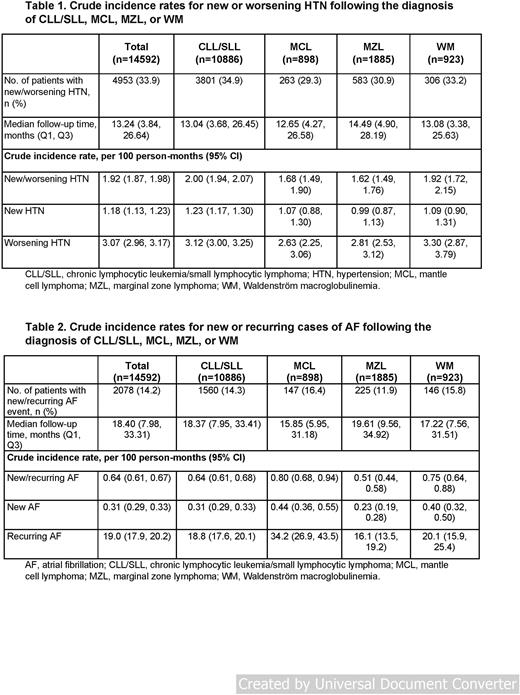Abstract
Background and objectives: Compared to the general population, patients with hematologic cancers have an increased risk of cardiovascular disease (CVD) (Strongman, 2019). Given this context, pre-existing CVD may add to the complexity of treatment decisions and patient management. Analyses were conducted to describe the burden of comorbidities and subsequent risks of hypertension (HTN) and atrial fibrillation (AF) in patients with newly diagnosed B-cell malignancies, including chronic lymphocytic leukemia/small lymphocytic lymphoma (CLL/SLL), mantle cell lymphoma (MCL), marginal zone lymphoma (MZL), or Waldenström macroglobulinemia (WM), regardless of treatment status.
Methods: Adult patients from the MarketScan insurance claims database who were newly diagnosed with CLL/SLL, MCL, MZL, or WM between 2015 and 2019 were included in the analyses. The first occurrence of a medical encounter for a B-cell malignancy was used as the index date. The outcomes were new or worsening HTN or new or recurring AF, stratified by the recent history of AF and HTN. In patients without a recent history of HTN, new HTN was defined as having ≥1 HTN diagnosis code and ≥1 antihypertensive prescription record. In patients with recent history of HTN, worsening of HTN was defined as having an increase in the number or doses of antihypertensive medications or as having an inpatient/emergency department admission due to HTN. In patients without recent history of AF, new AF was defined as having ≥1 inpatient claim or ≥2 outpatient claims on different days and/or an AF diagnosis with an electrocardiogram performed on the same date or within 30 days before the visit. Recurring AF was defined as above, occurring in patients with a recent history of AF. This analysis followed patients from index date until the occurrence of HTN, AF, death, or censoring, whichever came first.
Results: A total of 14,592 patients were eligible for the analysis, with a mean age of 66 years (SD=13.3), 56.7% male, and with a mean Charlson comorbidity index of 2.3 (SD=2.3). The overall incidence rate of new/worsening HTN was 1.92 per 100 person-months (95% CI=1.87, 1.98) (Table 1). In patients without recent history of HTN (n=7,692, 52.7%), the incidence rate of HTN was 1.18 per 100 person-months (95% CI=1.13, 1.23). In patients with recent history of HTN (n=6,900, 47.3%), the incidence of worsening HTN was 3.07 per 100 person-months (95% CI=2.96, 3.17), with a crude hazard ratio of 2.6 (95% CI=2.5, 2.8) compared to those without a recent history of HTN. After excluding patients on cancer therapies that have been shown to increase the risk of HTN, the new/worsening HTN incidence rate was 1.91 per 100 person-months (95% CI=1.84, 1.98; n=8,658).
The overall incidence rate of new/recurring AF was 0.64 per 100 person-months (95% CI=0.61, 0.67) (Table 2). In patients without a recent history of AF (n=13,288, 91.1%), the incidence rate of AF was 0.31 per 100 person-months (95% CI=0.29, 0.33). In patients with a recent history of AF (n=1,304, 8.9%), the incidence rate of recurring AF was 19.0 per 100 person-months (95% CI=17.9, 20.2), with a crude hazard ratio of 61.3 (95% CI=56.2, 66.8) compared to patients without a recent history of AF. After excluding patients on cancer therapies that have been shown to increase the risk of AF, the new/recurring AF incidence rate was 0.64 per 100 person-months (95% CI=0.60, 0.67; n=10,496).
Conclusions: The results of these analyses indicate that HTN and AF occur in a non-trivial proportion of patients with B-cell malignancies regardless of treatment status. HTN rates are nearly 3-fold higher in patients with pre-existing HTN, compared to those without it; the rate of AF is more than 60-fold higher in patients with recurring AF compared to newly diagnosed AF. The incidence rates are driven by cases in patients who have pre-existing diagnoses. These analyses highlight the importance of appropriate management of pre-existing CVD to be considered in selection of treatment regimens.
Disclosures
Zhou:BeiGene: Current Employment, Current equity holder in private company; Abbvie: Ended employment in the past 24 months. Yue:BeiGene USA, Inc.: Current Employment, Current equity holder in publicly-traded company, Divested equity in a private or publicly-traded company in the past 24 months. Azmi:BeiGene: Current Employment. Zhang:BeiGene: Current Employment. Cohen:BeiGene: Current Employment, Current equity holder in publicly-traded company, Other: TRAVEL, ACCOMMODATIONS, EXPENSES.
Author notes
Asterisk with author names denotes non-ASH members.


This feature is available to Subscribers Only
Sign In or Create an Account Close Modal